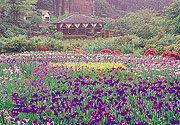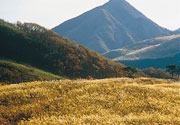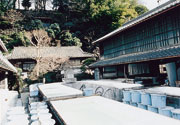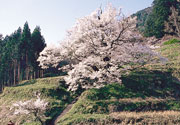 |
 |
| A mecca for iris
(hanashobu) lovers |
|
 |
 This
garden, which occupies a total area of 33,000 square meters,
is planted with 600 species of iris - 3.5 million plants in
all. In addition, the garden has a variety of other species,
including cherry blossom trees, manjushage (Lycoris radiata),
tessen (Clematis Florida), hydrangea, roses, and cosmos. Visitors
can enjoy shopping for seedlings and souvenirs or eating in
one of the restaurants. This
garden, which occupies a total area of 33,000 square meters,
is planted with 600 species of iris - 3.5 million plants in
all. In addition, the garden has a variety of other species,
including cherry blossom trees, manjushage (Lycoris radiata),
tessen (Clematis Florida), hydrangea, roses, and cosmos. Visitors
can enjoy shopping for seedlings and souvenirs or eating in
one of the restaurants.
 0745-92-3187
/ 9:00 - 17:00 / Early April to mid-July, Early September
to early November / Open 7 days a week 0745-92-3187
/ 9:00 - 17:00 / Early April to mid-July, Early September
to early November / Open 7 days a week
  800 800
 A
25-minute walk from Kintetsu Sanbonmatsu Station (Shuttle
bus services are available in fall, connecting the garden
and Sanbonmatsu Station in 6 min.) (On Saturdays, Sundays
and everyday during the early summer flower seasons, Kintetsu
bus operates between the garden and Sanbonmatsu Station -
a 7 min. journey.) A
25-minute walk from Kintetsu Sanbonmatsu Station (Shuttle
bus services are available in fall, connecting the garden
and Sanbonmatsu Station in 6 min.) (On Saturdays, Sundays
and everyday during the early summer flower seasons, Kintetsu
bus operates between the garden and Sanbonmatsu Station -
a 7 min. journey.) |
 |
 |
 Soni
Plateau is a smooth hill extending to the south of Mt. Kuruso
(1,038m above sea-level) located at the boundary of Nara and
Mie Prefectures. The plateau forms a part of the Murou Akame
Aoyama Quasi National Park, and is a very popular hiking spot.
From spring to summer, the entire plateau is covered with
green grass, while in fall, pampas grass turns the entire
hill silver. The top of the plateau gives a panoramic view,
and a campsite is open from April to November. Soni
Plateau is a smooth hill extending to the south of Mt. Kuruso
(1,038m above sea-level) located at the boundary of Nara and
Mie Prefectures. The plateau forms a part of the Murou Akame
Aoyama Quasi National Park, and is a very popular hiking spot.
From spring to summer, the entire plateau is covered with
green grass, while in fall, pampas grass turns the entire
hill silver. The top of the plateau gives a panoramic view,
and a campsite is open from April to November.
 0745-94-2101
(Soni Village Hall) 0745-94-2101
(Soni Village Hall)
 Take
bus from Kintetsu Nabari Station and get off at Taraji. A
50-minute walk from the bus stop (On Sundays and national
holidays in fall, a bus service is available from Kintetsu
Haibara Station to Soni Plateau - a 80 min. journey.) Take
bus from Kintetsu Nabari Station and get off at Taraji. A
50-minute walk from the bus stop (On Sundays and national
holidays in fall, a bus service is available from Kintetsu
Haibara Station to Soni Plateau - a 80 min. journey.) |
 |
 |
 |

Former Morino Herb Garden |
 |
| An old herb garden
dating back to the Edo Period |
|
 |
 In
the 18th century (Edo Period), Tokugawa Yoshimune, the 8th
Shogun, searched for herbs throughout Japan to open his herb
garden. Tosuke Morino, a herb researcher and breeder of 'Yoshinokuzu'
(herbaceous perennial legume) helped the Shogunate so much
that he was given seeds of precious herbs from the Shogunate
in recognition of his contributions. This is the origin of
the Morino Herb Garden. Today more than 250 types of herbs
and other rare species are grown at the former site of the
Morino Herb Garden. In
the 18th century (Edo Period), Tokugawa Yoshimune, the 8th
Shogun, searched for herbs throughout Japan to open his herb
garden. Tosuke Morino, a herb researcher and breeder of 'Yoshinokuzu'
(herbaceous perennial legume) helped the Shogunate so much
that he was given seeds of precious herbs from the Shogunate
in recognition of his contributions. This is the origin of
the Morino Herb Garden. Today more than 250 types of herbs
and other rare species are grown at the former site of the
Morino Herb Garden.
 0745-83-0002
/ 9: 00 - 17: 00 / Open 7 days a week 0745-83-0002
/ 9: 00 - 17: 00 / Open 7 days a week
  300 300
 Take
bus No.1 from Kintetsu Haibara Station and get off at Ouda
[‘å‰F‘É]. A 3-minute walk from the bus stop Take
bus No.1 from Kintetsu Haibara Station and get off at Ouda
[‘å‰F‘É]. A 3-minute walk from the bus stop |
 |
| Mochizukizakura
(a cherry blossom tree) in full bloom. |
|
 |
 Butsuryuji
Temple was founded in 850 A.D. by the Priest Kenne, a disciple
of Kukai (Kobodaishi) who founded Shingon Sect Buddhism. In
front of the temple is the old Mochizukizakura cherry blossom
tree designated as a natural monument by Nara Prefecture.
The cherry tree is said to be 900 years old, the circumference
of its trunk is 7m, and in spring, the blossom laden branches
hang down to the ground. The sanctuary also contains a thirteen-story
stone pagoda built in 1330 and other buildings. Butsuryuji
Temple was founded in 850 A.D. by the Priest Kenne, a disciple
of Kukai (Kobodaishi) who founded Shingon Sect Buddhism. In
front of the temple is the old Mochizukizakura cherry blossom
tree designated as a natural monument by Nara Prefecture.
The cherry tree is said to be 900 years old, the circumference
of its trunk is 7m, and in spring, the blossom laden branches
hang down to the ground. The sanctuary also contains a thirteen-story
stone pagoda built in 1330 and other buildings.
 0745-82-2714
(Haibara Town Industrial Divn.) / 9:00 - 16:00 / Open 7 days
a week 0745-82-2714
(Haibara Town Industrial Divn.) / 9:00 - 16:00 / Open 7 days
a week
 Admission
fee: Admission
fee:  100 100
 Take bus No. 25 or 27 from Kintetsu Haibara Station and get
off at Takai. A 40-minute walk from the bus stop
Take bus No. 25 or 27 from Kintetsu Haibara Station and get
off at Takai. A 40-minute walk from the bus stop |
|

